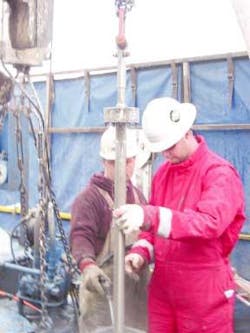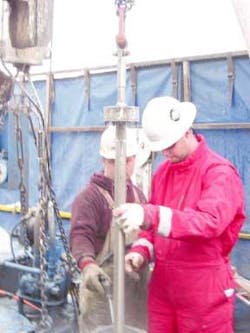Drilling & Production
Frank Hartley • Houston
New gyro in MWD
With the constant pressure to increase reserves, many operators are choosing to redevelop older fields from existing structures rather than invest huge amounts of capital in new platforms. This drives the need to re-use some of the slots on the platform and drill new wellbores within the existing well matrix.
Drilling new wells in the presence of existing wellbores, which can cause magnetic interference on magnetic referenced measurement-while-drilling (MWD) tools during the initial kickoff of the well, can make it impossible to know the actual location of the well and creates the risk of collision with the original wells. Current practice is to run a wireline gyro to orient the directional assembly, and take a survey every 30 ft until the well is drilled deep enough to gain separation from adjacent wells and potential magnetic interference.
Between survey points, the directional driller is basically "blind," drilling without any real-time orientation feedback, and running the risk of collision with a nearby well. In addition to this risk, a great deal of time is consumed with running the gyro instrument in and out of the well to survey every connection.
To eliminate this problem, Halliburton has introduced a survey instrument into its MWD system to measure the horizontal component of the earth's spin rate that is immune to the magnetic interference created by the casing strings in adjacent wells. Including the gyro in the MWD system enables the tool orientation and survey information to be pulsed to the surface in real time, eliminating the time associated with stopping the drilling process to run the gyro in and out of the drillstring to acquire the survey data.
When a survey is requested, the system sends up both a magnetic and a gyro survey for comparison. The survey information includes quality-control data enabling analysis to quantify the presence of magnetic interference. Once it becomes clear that nearby wells are no longer causing magnetic interference, the gyro sensor is turned off to conserve battery power, and the primary directional guidance reverts to the conventional magnetic MWD.
Since the introduction of directional steering tools, kicking a well off from vertical has required the use of magnetic sensors until the inclination was built up to 3° to 5°, where gravity-based accelerometers (inclinometers) would begin to function with sufficient accuracy to provide reliable measurements.
This method works fine unless there is magnetic interference from casing strings in adjacent wells. Most offshore platforms are designed to allow multiple wells to be drilled and cased from the platform to produce sufficient hydrocarbons to justify the high initial capital cost of the structure. With the advent of 3D seismic technology, older fields are being re-evaluated, and new targets are being generated under these existing structures. Some of these platforms have 40, 50, or 60 wells drilled from them, creating a tangled web of casing strings, a minefield to be navigated.
The Evader MWD gyro system from Sperry-Sun was developed to fill the industry need for faster, safer functions at low angles, and more accurate drilling from offshore multi-well platforms. This system is used in conjunction with Sperry-Sun's current fleet of magnetic directional probes, simultaneously sending up a magnetic survey and a gyro survey on request at each pump cycle, as well as providing real-time steering information for maintaining steerable system orientation.
Gulf of Mexico test
The system can also be used to orient a whipstock inside of casing to mill a window in the desired direction for a re-entry drilling application. Instead of requiring a wireline gyro to be tripped in to orient the whipstock, the whipstock can be attached to the mill, oriented via the Evader MWD, and set, all in one step.
Recently, its first field test was completed on a well that was kicked off for an operator in the Gulf of Mexico. Because the system steered the well away from other wellbores without interruption by magnetic interference, the operator was able to avoid spending extra rig time previously associated with using a wireline tool.
null
The total footage drilled was more than 2,000 ft, with magnetic interference present for approximately half of the footage. At one point, the well path came within 6 ft of one of the nearby wells before navigating past it. All of the footage was drilled without running a wireline-based gyro tool, thus reducing the HSE risks involved with having a wireline tool in the hole, reducing the risks of drilling without continuous directional data updates, and saving several hours of operation. Having a wireline in the well during the drilling process also creates a hazardous condition should the well take a kick due to the interference of the wireline with the proper sealing of the blowout preventers.
"The use of this real-time MWD service will help operators improve on the time required to drill the upper sections of platform wells, as well as reduce the risk of drilling into nearby wells, which can cause major production losses," says Brady Murphy, vice president, Halliburton Sperry-Sun. "The development of this tool fits Halliburton's mission statement of providing solutions in real time to meet our customers' needs. Because the Evader MWD gyro service is fully compatible with our Stellar suite of MWD/LWD tools, full geological evaluation and directional analysis can be performed simultaneously to provide a complete solution for upper hole sections of platform work."
The tool underwent extensive testing prior to this job. It will be available in 6-3/4-, 8-, and 9 1/2-in. collar sizes.
Elmer Sperry, one of Sperry-Sun's founders, developed the gyrocompass, which, unlike other compasses, was not affected by the magnetism of the earth and became extremely useful in ocean navigation. From the gyrocompass, Sperry developed the gyropilot for steering ships and the automatic gyropilot for stabilizing airplanes. The automatic pilot is credited with launching the entire modern era of long distance navigation, opening the door for everything from transoceanic flights, satellites, missile guidance systems and the entire space program. While the system goals are much more mundane, the catastrophic consequences of drilling into a producing well and the resulting environmental disaster require operators to take every precaution to eliminate this risk. The system allows wells to easily and quickly be steered through this potential minefield with confidence.

